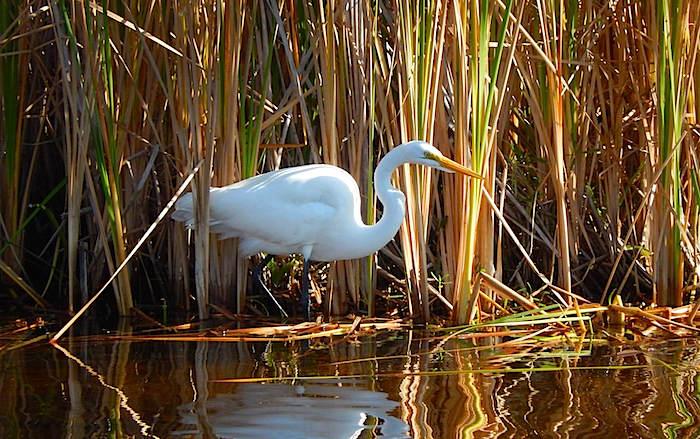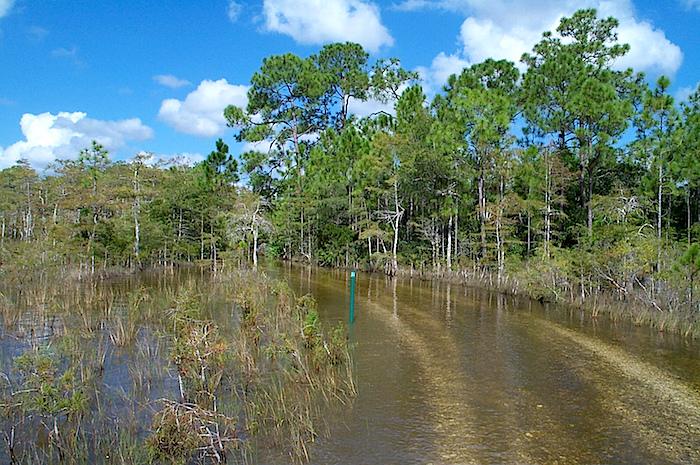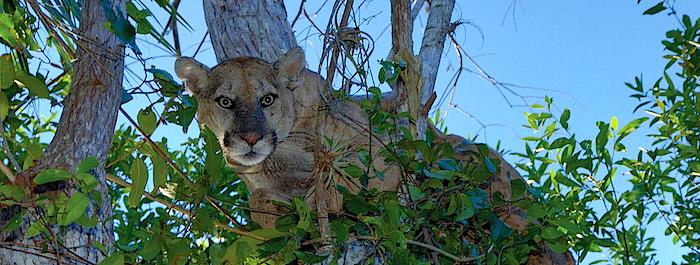
Big Cypress National Preserve in Florida seems to be at a crossroads over preservation and use/NPS
Fewer than 100 miles separate Big Cypress National Preserve in Florida from Biscayne National Park, yet when it comes to views on preservation the two parks appear light-years apart.
It's a conundrum that shouldn't exist within an agency -- the National Park Service -- that has operated under a unique, and specific, charter handed it in 1916. That charter, the National Park Service Organic Act, clearly placed preservation above all else as the Park Service's mission, a position federal courts time and again have upheld.
That mission was further buttressed in 1978 when Congress expanded Redwoods National Park and attached to the legislation an amendment that stated that all units of the National Park System should be managed and protected "in light of the high public value and integrity of the national park system."
That seems to be the goal being pursued at Biscayne, where the Park Service recently released a plan, championed by Superintendent Brian Carlstrom and approved by agency Director Jon Jarvis, to create a marine reserve zone to improve the health of its fisheries and help recover and protect a key part the Florida Reef, the only living coral barrier reef in the United States.
While the zone -- which some members of Florida's congressional delegation are trying to block -- would ban fishing on 6 percent of the 172,924-acre park, the designation would not stand in the way for snorkelers, scuba divers, or glass-bottom boats to experience and enjoy the reserve.
But at Big Cypress, the agency seems to be turning a blind eye on preservation as it works to develop a backcountry access plan in conjunction with a formal wilderness designation plan. The puzzler is that, at present, it appears the Preserve staff wants to roll back court-upheld limits on where off-road vehicles can travel in Big Cypress.
How the National Park Service has approached wilderness eligibility and designation at Big Cypress, as well as ORV access, have been contentious issues almost from the time the preserve was established in the mid-1970s. Since an off-road vehicle plan was approved in 2000, the issue of ORV use has led to a regular parade to courts by organizations that think too much of Big Cypress is being given over to motorized recreation.
There's no question that the preserve's enabling legislation permits ORV use:
In administering the preserve, the Secretary (of the Interior) shall develop and publish in the Federal Register such rules and regulations as he deems necessary and appropriate (emphasis added) to limit or control the use of Federal lands and waters with respect to:
(1) motorized vehicles,
(2) exploration for and extraction or oil, gas, and other minerals,
(3) grazing,
(4) draining or constructing of works or structures which alter the natural water courses,
(5) agriculture,
(6) hunting, fishing, and trapping,
(7) new construction of any kind, and
(8) such other uses as the Secretary determines must be limited or controlled in order to carry out the purposes of this Act...
Key to that section are the words "necessary and appropriate." It's particularly worth noting that this section immediately follows the overall preservation mandate for Big Cypress: "Such lands shall be administered by the Secretary as a unit of the National Park System in a manner which will assure their natural and ecological integrity, in perpetuity, in accordance with the provisions of this Act and with the provisions of the Act of August 25, 1916."

How many miles of ORV trails are "necessary and appropriate" at Big Cypress National Preserve/NPS
When, as part of a legal settlement, he approved the 2000 ORV plan, former Superintendent John Donahue (now superintendent of Delaware Water Gap National Recreation Area) based his decision on biological information and suitability studies indicating that ORVs were damaging ecosystems and disturbing the Florida panther, an endangered species. That plan cut 23,300 miles of dispersed ORV trails in the preserve down to just 400 miles of designated trails. In Big Cypress's so-called Bear Island Unit, that plan called for a reduction of 55 miles of primary trails to just about 30 miles of primary trails and an unspecified amount of secondary routes.
Yet in Big Cypress's recently released "Wilderness Eligibility Assessment," a key document for use in crafting the Preserve's backcountry access plan, planners decided not to include as wilderness worthy some areas that were placed off-limits to ORVs by the 2000 plan, along with some areas that previously had been deemed suitable for wilderness designation.
While Bill Reynolds, regional public affairs officer for the Park Service's Southeast Region, said the plan could be further altered during a more formal wilderness study, the agency could have avoided any controversy by underscoring the 2000 ORV plan. Instead, they left the door open to further motorized encroachment on valuable flora and fauna habitat.
Under the Park Service's 2006 Management Policies (Section 6.2.1.2), the areas in question could be considered for wilderness designation. Wilderness Eligibility Assessments are supposed to be objective documents based on the characteristics of the lands involved and their potential to be managed as wilderness; if there are current or historical uses that wouldn't be permitted in designated wilderness (such as ORV trails), NPS policy says they should not be excluded from being considered "wilderness-eligible" if "their wilderness character could be … restored through appropriate management actions."
At stake at Big Cypress are not only the 33 animal and 120 plant species that are considered threatened or endangered under the Endangered Species Act that are holding on in the preserve, but the very landscape itself. When Congress established Big Cypress in 1974, the legislation specifically cited "the natural, scenic, floral, and faunal values of the preserve as being worthy of national recognition and protection on their own merit."
In the preserve's Business Plan, adopted in 2010, wildlife biologist Deborah Jansen of the park's resource management division said, "There are few places left where a panther can live its entire life without crossing a highway. Big Cypress is one of them. The wetlands of Big Cypress provide food; the uplands provide cover. As privately-owned lands are developed and become unsuitable for panthers to use, the public lands will remain their only refuge."
Big Cypress's approach toward ORV access is particularly confounding not only in light of the park's own legislation, the National Park Service Organic Act of 1916 , and the Redwood Amendment, but also in light of the Revisiting Leopold: Resource Stewardship in the National Parks report that Director Jarvis approved in 2012. The core message contained within the 23-page report was that the Park Service should tread more carefully with its management decisions when they could impact the natural, and even cultural, worlds within the national parks.
Because ecological and cultural systems are complex, continuously changing and not fully understood, NPS managers and decision makers will need to embrace more fully the precautionary principle as an operating guide. Its standard is conservative in allowing actions and activities that may heighten impairment of park resources and consistent in avoiding actions and activities that may irreversibly impact park resources and systems. The precautionary principle requires that stewardship decisions reflect science-informed prudence and restraint. This principle should be integrated into NPS decision making at all levels.
While Big Cypress planners expressly cited the "precautionary principle" when they crafted the 2000 ORV plan (page 29), today's planners at the preserve seem to have both forgotten that and not read Revisiting Leopold.
At the same time, what should superintendents across the National Park System take away from Big Cypress's approach to preservation, as well as the message in Revisiting Leopold? Can the Park Service simultaneously employ the precautionary principle and actively work to open up ORV access in areas where the vehicles previously were banned?

Should the Park Service more strenuously apply the "precautionary principle" before allowing more ORV routes in Florida panther habitat?/NPS
In crafting a management plan several years ago for the 150,000-acre Addition Lands section of the preserve, Big Cypress managers decided it would be OK to open 100 miles of ORV trails through the sub-tropical landscape of freshwater sloughs and hardwood hammocks, of pinelands and prairies that are home to the panther.
True, a lawsuit produced a ruling that the Park Service was justified in placing recreation over preservation at Big Cypress, citing the multiple-use requirement specific to the act. That ruling will be appealed by conservationists.
Another lawsuit could be in the offing over the most recent Wilderness Eligibility Assessment at Big Cypress. Officials with the National Parks Conservation Association and the South Florida Wildlands Association were surprised by the report, for it could be used to open up ORV areas placed off-limits by the preserve's 2000 ORV plan.
While Bob DeGross, the preserve's chief of interpretation and public affairs, says the lands placed off-limits by the 2000 plan don't qualify as wilderness because there are old ORV tracks visible in places, two points should be noted:
1) The 2000 ORV plan called for a long-range restoration program to “remove the scars caused by vehicles and recover a sustainable, self-regulating, self-organizing ecosystem, by restoring to the extent possible the biological, physical, and chemical characteristics of the system” (page 55), and;
2) The Eastern Wilderness Act of 1975 was passed by Congress with exactly these types of lands in mind.
Shenandoah National Park officials pointed that out in explaining how nearly 80,000 acres of their park in 1976 came to carry the official wilderness designation.
Before Shenandoah was established as a national park in 1935, the land had been privately owned and was inhabited, farmed, grazed, burned, logged, and mined by several generations of people. But, by the 1960s, Shenandoah's forest was able to naturally regenerate and significantly recover from prior human use. National Park Service officials recognized the value of Shenandoah's restored wilderness conditions, and believed that designated areas in the park possessed qualities described in the Wilderness Act. Fortunately, the Eastern Wilderness Act allowed Shenandoah to designate over 40% of the Park's land as Wilderness in 1976.
The Park Service's approach to "wilderness" at Big Cypress has long been questionable. In 2002, a Wilderness Suitability study conducted under Superintendent Donahue concluded that 353,757 acres, 49 percent of the preserve, had wilderness qualities. That acreage is almost twice the landmass the Big Cypress staff most recently said possessed wilderness qualities.
Since that report (attached) was submitted to the Park Service's Southeast Regional Office, preserve superintendents have worked to reduce the footprint of potential wilderness.
Karen Gustin, who succeeded John Donahue as superintendent, in 2007 went beyond the 2000 ORV plan and opened an additional 22 miles of ORV trails in the Bear Island Unit in the preserve's northwestern corner. Four years later a federal judge reversed that decision, saying Superintendent Gustin failed to adhere to the National Environmental Policy Act, the Endangered Species Act, the Administrative Procedures Act, violated past Executive Orders pertaining to off-road vehicles, the Big Cypress Establishment Act, the National Park Service Organic Act, and the Preserve's 2000 ORV Management Plan. She earned a promotion to Olympic National Park as superintendent.
Pedro Ramos, who succeeded Superintendent Gustin, also worked to expand ORV access to the preserve. In 2010, while overseeing a wilderness eligibility study of the Addition Lands, the superintendent discarded a finding in his 2009 Draft General Management Plan for the Addition that approximately 109,000 acres were “wilderness eligible." Instead, a “re-assessment” conducted outside of public view concluded that only 71,000 acres were eligible. Of that, Superintendent Ramos recommended just 47,000 acres be proposed to Congress as future wilderness. Mr. Ramos early this year was promoted to superintendent at Everglades National Park, which contains the largest designated wilderness area east of the Rockies.
"Forty-thousand acres were removed to allow for mile-wide ORV corridors through some of the most pristine wild lands in the East - the Mullet Slough," says Frank Buono, who the Park Service's wilderness office had sent to Big Cypress during Superintendent Gustin's stint there to survey the Additional Lands for wilderness suitability.
"The NPS's latest wilderness review for the original preserve is designed (as with the Addition) to keep many areas of the preserve open to future ORV trails - many miles of them," Mr. Buono, who also previously had surveyed the rest of Big Cypress for wilderness qualities, told the Traveler. "The NPS clearly has the intent to broaden the routes open to ORVs far beyond those designated in the 2000 ORV Plan. They will call these 'secondary' routes and again bring the NPS nearly back to where it was BEFORE the 2000 plan. This is a case of the NPS trying to undo the good work, vindicated in court, of a past manager to accomodate the current management view."
That Director Jarvis signed off on Big Cypress's latest wilderness assessment, as well as its Addition Lands plan before then, is surprising. The director came to his job with a long Park Service career underscored by his natural resource background.
In an interview shortly after he had been confirmed, Director Jarvis told the Traveler that he had the mettle, and the scientific background, to separate the politics from the best interests of the parks.
"I bring to the position a scientific background. I have always been an advocate for the procurement and application of excellent science to our decision-making process, that all of our decisions should be informed by and guided by good science, and I think that that is one reason that they asked me to serve," he said in October 2009.
During that conversation, he made a point of saying, "the National Park Service has not been particularly articulate about the economic benefits of parks in their preservation state. That there are all kinds of positive benefits, ecosystem services like water and air that are cleansed by our parks, wildlife that contribute to local economies, lifestyle in gateway communities, that are contributed to by the presence of the park, all those kinds of things.
“I think we have been over time not as articulate and as convincing of the economic values to sort of counter the desires of those that might have kind of short-term economic benefit desires for some form of development or recreational use or whatever."
Such comments, placed against the decisions made at Big Cypress, raise questions of whether the Park Service is bowing to political undercurrents in Florida to greatly expand ORV access in the preserve.
At this point we can only hope that Tamara “Tammy” Whittington, who comes to the preserve as its new superintendent from her most recent position as the Park Service's associate regional director of resource stewardship and science, hews more closely to the National Park Service Organic Act of 1916 as well as the Revisiting Leopold report in guiding the preserve's backcountry access and wilderness plans forward.



Comments
Comparing Biscayne to Big Cypress is an apples to oranges comparison and unfair to the NPS staff & superintendents at BiCy. As a National Preserve, Big Cypress falls under a wildly different mandate than National Parks such as Biscayne.
As part of the 1974 compromise legislation, a whole host of activities are permitted in BiCy that National Park superintendents will never have to deal with. To pretend that BiCy and Biscayne share common problems with common solutions is disingenuous at best. It's little wonder that BiCy Park Service morale remains as fickle as it is... every interest group screams bloody murder as BiCy walks a razor's edge of compromise.
Personally, I agree with the gist of your article (and that said from a many year OVR permit holder). But let's not be close minded to the difficult and unique task that BiCy management must deal with.
Kind regards,
Chris Meyers